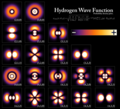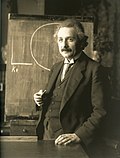In plasmas and electrolytes, the Debye length λ D {\displaystyle \lambda _{\rm {D}}} (Debye radius or Debye–Hückel screening length), is a measure of a...
19 KB (2,717 words) - 15:18, 17 May 2024
Intermolecular force (redirect from Debye force)
Hydrogen bonding Ion–dipole forces and ion–induced dipole force Cation–π, σ–π and π–π bonding Van der Waals forces – Keesom force, Debye force, and London dispersion...
28 KB (3,469 words) - 10:44, 12 September 2024
Van der Waals force (redirect from Van der Waals forces)
der Waals forces are usually described as a combination of the London dispersion forces between "instantaneously induced dipoles", Debye forces between...
35 KB (3,940 words) - 13:38, 30 August 2024
limitations on its validity. For instance, it does not include Debye length κ−1 (units m). However, Debye length must be important for electrophoresis, as follows...
16 KB (1,989 words) - 13:46, 22 August 2024
equation Davies equation Debye–Hückel equation Debye–Hückel theory Double layer (interfacial) Double layer (electrode) Double layer forces Electrical double...
7 KB (1,015 words) - 05:46, 11 February 2023
Non-covalent interaction (section Van der Waals forces)
dipole interactions, or the Debye force induced dipole-induced dipole interactions, commonly referred to as London dispersion forces Hydrogen bonding and halogen...
28 KB (3,363 words) - 00:54, 15 December 2023
Casimir effect (redirect from Casimir forces)
"Electromagnetic vacuum fluctuations, Casimir and Van der Waals forces" (PDF). Annales de la Fondation Louis de Broglie. 29 (1–2): 311–328. arXiv:quant-ph/0302072...
63 KB (7,996 words) - 03:33, 30 August 2024
factor of 10−10 statcoulomb being 0.208 units of elementary charge, so 1.0 debye results from an electron and a proton separated by 0.208 Å. A useful conversion...
24 KB (2,751 words) - 06:38, 15 August 2024
the Debye length there can be charge imbalance. In the special case that double layers are formed, the charge separation can extend some tens of Debye lengths...
75 KB (7,945 words) - 04:31, 1 September 2024
RWTH Aachen University (category CS1 German-language sources (de))
Nobel laureate Peter Debye received a degree in electrical engineering from RWTH Aachen and is known for the Debye model and Debye relaxation. Another...
48 KB (3,581 words) - 08:30, 20 August 2024
Van der Waals forces (forces between stable molecules), with Van der Waals molecules (small molecular clusters bound by Van der Waals forces), and with Van...
25 KB (3,021 words) - 16:51, 2 September 2024
relationships between force, matter, and motion among physical objects. Forces applied to objects result in displacements, which are changes of an object's...
22 KB (2,570 words) - 01:04, 4 August 2024
accelerations of the particles are imparted directly by forces, which exist in physical three-dimensional space. In de Broglie–Bohm theory, the quantum "field exerts...
125 KB (16,731 words) - 04:07, 6 September 2024
Walther Bothe), Wilhelm Hanle, Gerhard Hoffmann, and Georg Joos; Peter Debye was invited, but he did not attend. After this, informal work began at the...
74 KB (9,635 words) - 16:39, 10 August 2024
for the materials (for example, the Debye model) and Bose–Einstein statistics. Energy is given simply by the De Broglie Wavelength Equation: E = ...
22 KB (2,843 words) - 02:23, 6 April 2024
Werner Heisenberg (category CS1 German-language sources (de))
Sommerfeld: Heisenberg, who had received the Nobel Prize in Physics; Peter Debye, who had received the Nobel Prize in Chemistry in 1936; and Richard Becker...
124 KB (13,586 words) - 23:50, 7 September 2024
Zero-point energy (category CS1 German-language sources (de))
energy "dead as a doornail". Zero-point energy was also invoked by Peter Debye, who noted that zero-point energy of the atoms of a crystal lattice would...
209 KB (26,936 words) - 19:57, 2 September 2024
Colloid (category CS1 German-language sources (de))
can be accomplished by the addition of salt to a suspension to reduce the Debye screening length (the width of the electrical double layer) of the particles...
43 KB (4,872 words) - 20:40, 17 July 2024
applied electric and magnetic fields. Responses to external mechanical forces and vibrations can be calculated as well. Consider a quantum system described...
6 KB (1,072 words) - 22:48, 10 January 2024
values depend on the ionic strength I of the solution, as described by the Debye–Hückel equation, at zero ionic strength one observes ΔG = 8 kJ/mol. The...
21 KB (2,523 words) - 08:06, 1 August 2024
Quantum mechanics (category CS1 German-language sources (de))
work of Planck, Einstein and Bohr mentioned above, Einstein and Peter Debye's work on the specific heat of solids, Bohr and Hendrika Johanna van Leeuwen's...
98 KB (12,084 words) - 11:03, 1 August 2024
Buerger Sir Gordon Cox Francis Crick D. W. J. Cruickshank Pierre Curie Peter Debye Johann Deisenhofer Boris Delone Gautam R. Desiraju Eleanor Dodson Jack Dunitz...
21 KB (2,204 words) - 13:41, 6 September 2024
Earle K. Plyler Prize (1993), the Herbert P. Broida Prize (1995), the Peter Debye Award (1996), the Tolman Award (1997), the Robert A. Welch Award (1997)...
32 KB (2,792 words) - 21:01, 11 September 2024
Phases of ice (category CS1 German-language sources (de))
is primarily crystalline. This is thought to be the result of competing forces: the thermal crystallization of amorphous ice versus the conversion of crystalline...
135 KB (15,334 words) - 14:44, 20 August 2024
that an 'atom' is a material point, invested and surrounded by 'potential forces' and that when 'flying molecules' strike against a solid body in constant...
51 KB (7,758 words) - 07:43, 6 September 2024
Wave–particle duality (redirect from De Broglie Wave-Particle Duality)
characterized by positions and velocities that vary over time; in the absence of forces their trajectories are straight lines. Stars, planets, spacecraft, tennis...
29 KB (3,082 words) - 11:28, 17 August 2024
Photon (category CS1 German-language sources (de))
Einstein's later work searching for a more complete theory. In 1910, Peter Debye derived Planck's law of black-body radiation from a relatively simple assumption...
107 KB (11,683 words) - 10:54, 17 August 2024
Andrew Lenard (de), who considered the balance of attractive (electron–nuclear) and repulsive (electron–electron and nuclear–nuclear) forces and showed that...
25 KB (3,449 words) - 13:58, 4 August 2024
Double-layer capacitance (category CS1 German-language sources (de))
of ions in the solvent. It ranges from 0.1 to 10 nm as described by the Debye length. The sum of the thicknesses is the total thickness of a double layer...
12 KB (1,440 words) - 22:27, 10 May 2024
Albert Einstein (category CS1 German-language sources (de))
mechanics could solve the specific heat problem in classical mechanics. Peter Debye refined this model. In 1924, Einstein received a description of a statistical...
223 KB (22,452 words) - 20:34, 11 September 2024


















